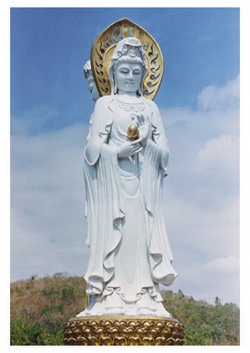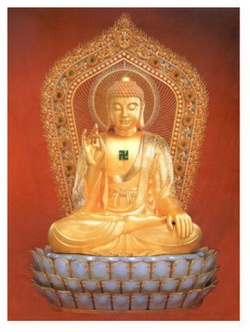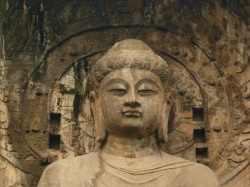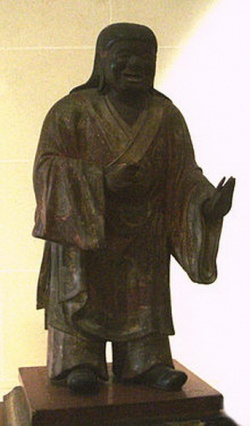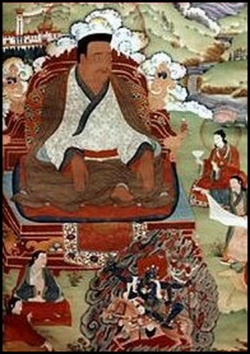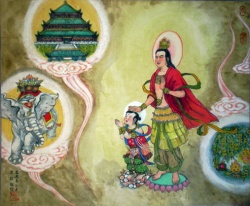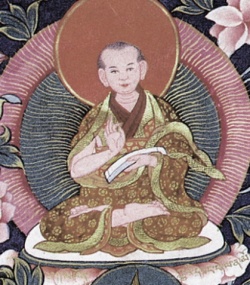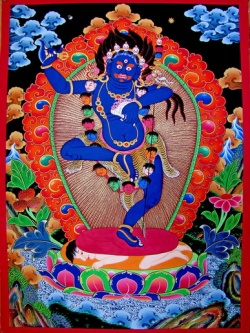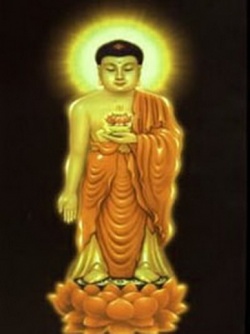A Yogacara-Buddhist Critique
By Chen-Kuo Lin
Department of Philosophy National Chengchi University
Absolute fear would then be the first encounter of the other as other: as other than I and as other than itself. I can answer the threat of the other as other (than I) only by transforming it into another (than itself), through alternating it in my imagination, my fear, or my desire. Jacques Derrida( µù 1)
The history of society and culture is, in large measure, a history of the struggle with the endlessly complex problems of difference and otherness. Never have the questions posed by difference and otherness been more pressing than they are today. Mark C. Taylor( µù 2)
Jacques Derrida , Of Grammatology , trans . by Gayatri C.Spivak, Baltimore: The Johns Hopkins University Press, 1976, p. 277. (µù2) Mark C.Taylor,Altarity,Chicago: The University of Chicago Press, 1987, p. xxi.
The pressing of the philosophical problem of otherness and difference is now evidenced in all minority discourses. For the oppressed subjects in a long history, such as woman, Jews, subaltern, (post-)colonial cultures, and so on, the time has come to rewrite and rediscover their own identities. However, in their efforts to do so, they are inevitably trapped in a paradoxical situation. Their search for a new identity through reversing the relationship between master and slave, as Hegel suggests, would not escape the dominating desire embedded in the same centric logic. The reclamation of subjectivity is always done at the expense of distorting the previous other. The political ambiguity (and guilt) as the result of constructing a reversed other therefore never stops haunting the souls who long for liberation. For this reason, the questions need to be readdressed for those who consider "encounter" to be the task free from distortion and domination: What is other? Is the other reducible to something other than itself? How could the other be properly understood and confronted? As an Oriental response to these questions, this paper deliberately takes a Buddhist stance, particularly that of the Yogacara school. How is other viewed in Yogacara philosophy? Although modern studies have been devoted to the epistemological issue about the existence of other minds raised by Yogacara philosophers Vasubandhu (fifth century) and Dharmakirti (seventh century), the critical--yet still implicit--relevance of the problem of otherness in Buddhism to the post-modern situation has not yet been elaborated.( µù 3) It is strategically necessary, as this paper attempts to do, to place Yogacara conception of otherness under the highlight of the post-modern discourse. Thomas E . Wood provides a detail study on the Yogacara ' s doctrine of other minds . See his Mind Only : A Philosophical and Doctrinal Analysis of the Vijbanavada (Honolulu: University of Hawaii Press, 1991).
Before directly going into Buddhist meditation on this issue, a brief scan of the problematic of otherness in the modern context could be helpful. The problem of other can be seen in the conflicting contrast between the notion of "system" emphasized by the structualists and the notion of "difference" favored by the post-structuralists. While the structuralists are much concerned with the inclusiveness and regularity of system, ( µù 4) the post-structuralists are rather worried about the totalizing and oppressive character of system. For the post-structuralists or the so-called "post- modernists", to defend the irreducibility of other is inseparable from their ethical and political concern. They do not want to see that everything is, in the final analysis, reduced to or "swallowed up" by system. In order to justify their ethico-political stance, they are forced to go further to provide the epistemological or phenomenological analysis for the question, "How is it possible for other to be thought or perceived?" In their inquiry, however, they trace the difficulty of problem back to the philosophical predicament of Cartesian dualism and solipsism: No difference is conceivable in identity. The various efforts done later by the "hermeneuticians of suspicion" -- Nietzsche, Freud, Marx -- are for this reason directed to rescuing difference and otherness from the metaphysics of identity. They take either genealogy, psychoanalysis, or politico-economical analysis, as a deconstructive tool to bring down this metaphysics. The reason for them to do this is that "violence", as Derrida calls it, occurs in the metaphysics of identity for its domination of nature and man.( µù 5) To disclose the
metaphysical making of sameness is hence required as the first step for us to truly recognize the other. In the Western history of metaphysics, as Heidegger contends, this "sameness" has been given different names: Physis, Logos, En, Idea, Enargeia, Substantiality, Objectivity, Subjectivity, the Will, the Will to Power, the Will to Will, and so on.( µù 6) When we look to the East, we find a similar development parallel to the West. In the Indian history of orthodox metaphysics, this sameness or identity is called Brahman, Rta, Atman (Self), svabhava (self- nature), prakrti (primordial nature), etc.. According to Buddhist philosophy, this conception of sameness is nothing but an illusive fabrication that causes sentient beings falling into the suffering cycle of life-and-death (sajsara). Suffering and metaphysics of sameness are as inseparable for Buddhism as for Adorno and Derrida. (µù7) However, the Buddhist critique of the metaphysics of the sameness does not necessarily lead to the conclusion the Western thinkers have arrived, namely, affirming the existence of the irreducible other. For Buddhism, this notion of "irreducible other" also needs to be examined carefully. 2 From the beginning, Buddhist considers "other" as that which is desired and constructed for the purpose of appropriation. This view is clearly stated in the Sajyukta-Agama 12.38:( µù 8)
In this passage, several points need to be noted: (1) In the world of life-and- death, everything is structured intertextually and inter-conditionedly. This is called "depending origination" (pratitya- samutpada) . (2) Between consciousness and its object there is no exception to the principle of depending origination. Both of them must be mutually conditioned. In other words, "consciousness" does not exist autonomously without confronting something as its "object", and vice versa. (3) Furthermore, "object" (alambana) results from intention and imaginative construction. This is equal to say, as Mahayanists claim later, that object is empty because it is necessitated by the intention and desire of consciousness. It also needs to note that in early Buddhism consciousness is characterized as something nourished by "foods" (ahara): solid food, contact, volition and consciousness. This view is radically different from the Cartesian conception of consciousness as the attribute of a substantial mind. On the side of Buddhism, consciousness is metaphorically depicted as being appetitive, ¢w¢w¢w¢w¢w¢w¢w¢w¢w¢w¢w¢w¢w¢w decay-and-death,or consciousness,name-form (namarupa), birth, decay-and-death. See Noritoshi Aramaki, "On the Formation of a Short Prose Pratitya-samutpada Sutra",in¡m¶³¤«¬Lµ½³Õ¤h¥jµ}°O©À:¦ò±ÐÇO²§©v±Ð¡n,Kyoto: Heirakuji Shoten, 1985, 87-122.
arising from and growing in the context of physical contact and ideological pursuit. Consciousness is understood as something always in need of constantly consuming "other", and conversely the other is constructed as an object for consumption. This appetitive character of consciousness introduces us to see how desire or Eros (trsna) is accompanied by consciousness. Desire, as stated in Four Noble Truths as the cause of samsaric suffering, plays a decisive role in rebirth. In the twelve-link formula of depending origination, desire is said to incite the arising of appropriation (upadana); appropriation goes on to cause the arising of becoming (bhava), birth, decay and death. This is a soteriological explanation of the cycle of life- and-death in early Buddhism. According to the same formula of dependent origination, the arising of desire is preceded by the process of cognition: feeling, sensory contact, senses, the embryonic form of mind-body (nama-rupa), consciousness, and so on. This explanation also makes a point in de-substantializing the notion of desire. If desire is conditioned by something else for its arising and hence empty by nature, it must be subjected to elimination. But in reading this dogmatic explanation, we should not overlook the dialectical relationship between desire and cognition: desire is conditioned by (defiled) cognition, and conversely cognition is also conditioned by desire. This is seen in the chain of the second link, sajskara (volition and karma), and the third link, vijbana (consciousness).( µù 10) Consciousness is said to be the embodiment of one's previous karmas which can in turn be traced back to appropriation and desire. Instead of grounding the whole world upon the Transcendental Mind as an Archimedean point, Early Buddhists rather conceive consciousness as that which is intertextually conditioned by the past. This way of thinking leads us
to disclose the genetic structure of the intentionality of consciousness in order to see the essence of object in cognition. They are clearly aware of the fact that the object of cognition is always already something manifested in the horizon of consciousness. Accordingly, the contemplation of an object must be preceded by analyzing the horizon of consciousness as genetically constituted by sajskara. However, Early Buddhists are not saying here that the essence of object can be perceived in the realist manner if the genetic structure of consciousness has been laid bare. On the contrary, they rather argue that the essence of object is nothing but the result of the objectification of consciousness embodied in sajskara. Put in other words, for Early Buddhists the "other" encountered in the horizon of consciousness is merely a construction of intentionality; to encounter an "other" is therefore the same as to encounter one's own past. The "other" standing out there is nothing but the "other" coming from within. 3 How is the other encountered from within? How is the other perceived as an other out there?
In responding to these questions, the Yogacara philosophers in the fourth and fifth centuries turned to the investigation of the depth of consciousness. They found that the dualistic schema of the knowing subject and the known object, which is assumed in realist epistemology, is in fact based on and effected by an inaccessible, subliminal matrix of consciousness. They call edit alaya -vijbana (storehouse-consciousness),ana-vijbana (appropriating -consciousness)or sarvabijakavijbana (consciousness -containing-all-seeds). They claimed that all sources of knowledge subsumed under the categories of the knowing "I " and the known "things" genetically arise from the storehouse-consciousness. Our perception and knowledge are merely representation of the storehouse-consciousness. 242 ¶ The notion of storehouse-consciousness was originally employed by the early Yogacarins to account for the continuity of "personal" existence during the meditative state of nirodhasamapatti (cessation of all kinds of mind and mental factors). Later the notion was used by the Yogacarins to explain the karmic continuity of "personal' existence in rebirth. The question they asked is: Why is the sentient being born in this life-world rather than that life-world? The main cause is "karma". But through what vehicle and in what form is karma transmitted to next life? Since the six kinds of sensory and apperceptive consciousness are not qualified as the receptacle of karmas, they are forced to excavate the underlying structure of consciousness which is inaccessible to reflection. ( µù 11)This finally leads to the discovery of alayavijbana. The discovery has its significance in disclosing the archaeological and semiological structure of subject. No longer able to hold its autonomous status, the knowing subject is now claimed to result from the linguistic and karmic matrix of the alayavijbana. The crucial questions for Yogacara philosophers are: What are the characteristics and structure of alayavijbana? How do we know them? According to The Sajdhinirmocana Sutra, the structure of alayavijbana is shown in the "stuffs" it appropriates (upadana): (1) the sense- faculties and their bases, and (2) the sediments (vasana) of discursive world (prapabca) and language (vyavahara) which are constituted through cognition (vikalpa), signifier (nama) and signified (nimitta).( µù 12) That means,
alayavijbana biologically clings to physical body, taking body as its base, and serving as the support of body, while it appropriates the sediments/seeds of language and discursive world as its contents. This second characteristic gives us an important clue to discern the linguistic structure of alayavijbana. How is the alayavijbana structured linguis- tically? As mentioned above, this subliminal consciousness is also called "consciousness- containing-all-seeds". The notion of "seed" (bija) in this context refers to the cause of both existence and cognition. In addition to the biological "seeds" which cause the arising of the physical body, two other kinds of seeds are also included in the alayavijbana: seeds of karma and seeds of language. The seeds of karma result from the maturation of past karmas, while the seeds of language result from the delight in "discursive world" (prapabca).( µù 13) It is particularly due to the latter (the linguistic sediments of discursive world) that an other is fabricated as an other. Here we have to clarify the concept of prapabca before we go on analyzing the Yogacara's conception of cognition as the effect of language. The term prapabca has different renderings by modern scholars: "the manifold of named things", ( µù 14) "Plurality", ( µù 15)"verbal elaboration, the ¢w¢w¢w¢w¢w¢w¢w¢w¢w¢w¢w¢w¢w¢w (or: consisting of the Impression of the diversity of (/proliferous involvement in ) the everyday usage of phenomena,names,and conceptions(*nimitta-nama-vikalpa- vyavahara-prapabca)". See, Alayavijbana, p. 71.
phenomenal world"( µù 16), "vain talk, diffusive trivial reasoning", ( µù 17) and so on. Among these expositions, Lambert Schmithausen's interpretation is most worthy of note:
`Prapabca' is used both in the sense of the process of proliferation, especially conceptual proliferation, or even of (emotionally involved) proliferating or diversifying conceptual activity, as also in that of what is the result of such a process ("diversity") or the object of such an activity.( µù18) According to this interpretation, prapabca is synonymous of sajvrti (conventional world) and sajsara (the world of life-and-death), both of which refer to the world fabricated by linguistic act and cognition.( µù 19) In ¢w¢w¢w¢w¢w¢w¢w¢w¢w¢w¢w¢w¢w¢w beginninglessly recurring cycle of birth and death, which consists of knowledge and objects of knowledge, words and their meanings,agents and action, means and act, pot and cloth , diadem and chariots, objects and feelings, female and male , gain and lose , happiness and misery , beauty and ugliness , blame and praise." See Mervyn Sprung, Lucid Exposition of the Middle Way, Boulder: Prajna Press (1979),p.172.Nagarjuna declares in the opening verse of the Madhyamakakarika that the complete cessation of the prapabca is called nirvana. See ibid. p. 33.
Yogacara Buddhism, this world is also called "the fabricated" (parikalpita), the life- world with which we live and interact. It is further explained that the fabricated world is constituted in the structure of the grasping subject (grahaka)( µù 20 ) and the grasped object (grahya). Both subject and object interact with each other in this psycho- lingusitically fabricated world. In the discursive world, the subject grasps the object and the signifier (nama) signifies the signified (nimitta). But what is the signified? Those which are signified arise from the transformation of the "seeds" in alayavijbana. Like the magic show on the street, the audience does see a "lion", for example, and says that "I do see a lion", though in fact it is nothing but the illusory image fabricated with stuffs and trick. The image of "lion", for example, is signified by the word "lion". And this image as the signified is actualized by the seeds of alayavijbana which in turn result from the "perfuming" effect (vasana) of language and discourse. Between discourse and alayavijbana (seeds) there exists causal circularity. According to Yogacara, consciousness is the consciousness-perfumed -by-language. But how is the consciousness "perfumed"? Obviously, "perfuming" as a metaphoric expression can not be clearly defined. One of the possible interpretations is to construe "perfuming" as "encoding" in the semiological sense and to construe "actualizing" or "transforming" the seeds into the perceptual image as a reverse process, namely, "decoding". However, ¢w¢w¢w¢w¢w¢w¢w¢w¢w¢w¢w¢w¢w¢w Chinese rendering, À¸½×, which literally means "drama discourse" or "the fabricated world in play".
this encoding-decoding model could be oversimplified, because it fails to see the complexity in the metaphoric and metonymic process (condensation and dispalcement) operating in between language and the Unconscious.( µù 22) On the other hand, the Lacanian project of discovering the metaphoric-metonymic structure of the Unconscious seems foreign to the Yogacara tradition. On the contrary, Yogacara takes a rather literal and pragmatic approach. According to the Sajdhinirmocana Sutra and the Yogacarabhumi-sastra,( µù 23) the effect of language is working on two states of consciousness: the awake state and the dormant state. In the awake state of consciousness, language arises with perception simultaneously.( µù 24) For example, when one perceives a table, one knows that "it is a table". In the dormant state of consciousness, one merely perceives something without conception and verbal expression.( µù 25) The examples given by Yogacara are those who are incapable of verbal communication, such as animals and babies. According to Yogacara, consciousness can never be regarded as tabula rasa. Even a baby's consciousness is always already embodied of the past karmas and language. It is therefore important in Yogacara practice to discern the function of language not only in the structure of consciousness, but also in the pre-structure of consciousness.
The language in the preconscious/preconceptual state is also called manojalpa, "preconscious/ preconceptual language".( µù 26) Yogacara argues, it is due to the conceptualization of "preconscious/ preconceptual language" that the "identity" (svabhava) of any perceived object is asserted. Only if this process of conceptualization is fully discerned and disclosed, one is able to realize the emptiness of "identity" and consequently eliminates his clinging and ignorance. In the Yogacara manual of mecditation, the disclosure of "preconscious/ preconceptual language" becomes a methodic entrance to enlightenment.( µù 27) It is important to see that, according to Yogacara, there is a correlative and corresponding relationship between the structure of "conscious language" and the structure of "preconscious language". The former is 0 usually listed in the standard Yogacara taxonomy of hundred dharmas. This doctrine sounds like psycho-linguistic atomism, claiming that all states of affairs can be reduced to the corresponding structure of language, which is further divided into two levels: conscious language and preconscious language. But how is this theory of correspondence justified? To Yogacara, theory shall be verified by practice only, not by any other theory. When a Yogacara student practices meditation of calming (wamatha) and discerning (vipawyana), s/he is instructed to meditate upon an object-image or any state of affair in order to realize that all states of affairs are nothing-but-consciousness (vijbaptimatra ), nothing-but-preconscious-language" (manojalpamatra) or nothing-but- designation
(prajbaptimatra).( µù 28) The workability of meditation is taken by Yogacara as the criteria to verify their doctrine. 4 In gazing at the face of other, Yogacara Buddhists are directed inwards to the pscycho- linguistic intertextuality and inter-conditionality which determines our ways of gazing and acting. For them, the others we encounter in mundane experience are mere object-images hypostatized from the pyscho- linguistic factors which are embedded in the storehouse-consciousness. They argue that the other and its reverse side, subject, are psycho- linguistically fabricated. To disclose the psycho- linguisticality of other is the tantamount to the same disclosure of subject, and hence gazing at other is the same as gazing at oneself.
But is there something called the real "Other" left when the fabricated other and self have been disillusioned? Could we reach at the real Other insofar as we have attended enlightenment? These questions are concerned with the practical implication of Yogacara philosophy. In contrast to the postmodernist's efforts to save the irreducible Other, Yogacara thinkers rather propose an/other way of gazing at the other: meta-gazing (paramartha- satya). Instead of being the path to secure the ontological status of the other, Yogacara's meta-gazing is taken to discern and purify the psycho-linguistically embodied mechanism of mundane gazing (samvrti-satya). This concealed mechanism of mundane gazing is the real "Other" that needs to be disclosed. For all Yogacara thinkers and Buddhists in general, the so-called "Absolute Other" or "Transcendental Other" in the onto-theological sense does not exist. The reality of the real is nothing but the fabricationality of the fabricated. Thus it is said in the Diamond Sutra:
This is the reality all we have. But still there is difference between mundane gazing and meta-gazing: To the former, mingling language with desire leads one to fall into the unhappy cycle of life-and-death, but to the latter the detachment of desire from language makes possible the playful prapabca (discursive world). As the problematic of other is concerned, the other appears to the Yogacara like the mirror reflecting all sorts of discursive networks without mutual hindrance and clinging when it is encountered with meta-gazing. This is called "freedom", "liberation", or "truth".
Abstract The pressing of the philosophical problem of otherness and difference is now evidenced in all minority discourses. For the oppressed subjects in a long history, such as woman, Jews, subaltern, (post-)colonial cultures, and so on, the time has come to rewrite and re(dis)cover their own identities. However, in their efforts to do so, they are inevitably trapped in a paradoxical situation: Their search for a new identity through reversing the relationship between master and slave, as Hegel suggests, would not escape the dominating desire embedded in the same centric logic. The reclamation of subjectivity is always done at the expense of distorting the previous other. The political ambiguity (and guilt) as the result of constructing a reversed other therefore never stops hunting the souls who long for liberation. For this reason, the questions need to be readdressed for those who consider "encounter" to be the task free from distortion and domination: What is other? Is the other reducible? How could the other be properly understood and confronted? As an Oriental response to these questions, this paper deliberately takes a Buddhist stance, particularly that of the Yogacara school, to see how other is viewed in the Yogacara tradition. This paper concludes that, in gazing at the face of other, the Yogacara Buddhists are directed inwards to the pscycho-linguistic intertextuality and inter-conditionality which determines our ways of gazing and acting. For them, the others we encounter in mundane experience are mere object-images hypostatized from the pyscho-linguistic factors which are embedded in the storehouse-consciousness. They argue that the other and its reverse side, subject, are psycho-linguistically fabricated. To disclose the psycho- linguisticality of other is the tantamount to the same disclosure of subject, and hence gazing at other is the same as gazing at self.
(µù1) Jacques Derrida , Of Grammatology , trans . by
Gayatri C.Spivak, Baltimore: The Johns Hopkins
University Press, 1976, p. 277.
(µù2) Mark C.Taylor,Altarity,Chicago: The University
of Chicago Press, 1987, p. xxi.
(µù3) Thomas E . Wood provides a detail study on the
Yogacara ' s doctrine of other minds . See his
Mind Only : A Philosophical and Doctrinal
Analysis of the Vijbanavada (Honolulu:
University of Hawaii Press, 1991).
(µù4) See Todd G. May,"The System and Its Fractures:
Gilles Deleuze on Otherness",in Journal of the
British Society for Phenomenology, 24.1, 1993,
3-14.
(µù5) Jacques Derrida makes this point through his
reading of Levinas. See Derrida, "Violence and
Metaphysics", in Writing and Difference, trans.
by Alan Bass,Chicago:The University of Chicago
Press,1978.Also see John McGowan,Postmodernism
and Its Critics , Ithaca : Cornell University
Press, 1991, p. 91.
(µù6) Martin Heidegger,Identity and Difference,trans.
by Joan Stambaugh, New York: Harper & Row, 1969,
p. 66.
(µù7) Theodor W.Adorno says ,"Auschwitz confirmed the
philosophy of pure identity as death" . See
Negative Dialectics,trans. by E. B. Ashton, New York: Continuum, 1983, p.262.
(µù8) As Noritoshi Aramaki (¯îªª¨å«T) has pointed out,
a three-or four-link formula of depending
origination(pratityasamutpada) is given in this
Agama: consciousness, birth,
(µù9) See Mrs Rhys Davids, trans . , The Book of the
Kindred Sayings, part II, p. 45.
The translation is slightly modified with
consulting the Tsa a-han ching ( Âøªü§t¸g ),
T.2.100.a-b.
(µù10) Sajskara, derived from ¡Ôkr (do, make, create)
with prefix sam, means " predispositions , the
effect of past deeds and experience as
conditioning a new state ; conditionings,
conditioned states , which is also meant by
sajskrta . " See Franklin Edgerton ,Buddhist
Hybrid Sanskrit Grammar and Dictionary ,Vol.
II, pp. 542-543.
(µù11) Lambert Schmithausen provides an excellent
textual-exegetical study on this issue. See
his Alayavijbana: On the Origin and the Early
Development of a Central Concept of Yogacara
Philosophy,Tokyo: The International Institute
for Buddhist Studies,1987.Also cf.,William S.
Waldron,"How Innovative is the Alayavijbana?",
Part I & II, Journal of Indian Philosophy 22:
199-258, 1994; 23: 9-51, 1995.
(µù12) Chieh shen-mi ching(¸Ñ²`±K¸g),T.16.692.b. Also
cf., Schmithausen's translation:"[Alayavijbana]
is based on a twofold upadana: 1) upadana of
(or:consisting of) the [[[Wikipedia:subtle|subtle]]] material sense-
faculties together with their [gross] bases and
2) upadana of
(µù13) In the Basic Section of Yogacarabhumi,
alayavijbana is taken as the bijawraya (the
basis in the form of seed ) of sensory
perceptions .It is understood as the basis of
apropriations as well as the maturation of
karma. See Yogacarabhumi (·ì¦÷®v¦a½×¡D¥»¦a¤À
¤ÃѨ¬ÛÀ³¦a)¡G¡uºØ¤l¨Ì¿×§Y¦¹¤@¤ÁºØ¤l°õ¨ü©Ò¨Ì
²§¼ô©ÒÄáªü¿àCÃÑ¡C...¤@¤ÁºØ¤lÃѿ׵L©l®É¨Ó¼ÖµÛ
À¸½×âÀ²ß¬°¦]©Ò¥Í¤@¤ÁºØ¤l²§¼ôÃÑ ¡C ¡vT.30.279.
a-b. Also cf. Schmithausen, Alayavijbana,Part
I, p. 110.
(µù14) In the Prasannapada , Candrakirti gives a
lengthy exposition for the notion of prapabca:
"Thus karmic action and the afflictions arise
from hypostatizing thought . Hypostatizing
thought springs from the manifold of named
things (prapabca), i.e., from the
(µù15) Th. Stcherbatsky took a monist interpretation
in his translation of Prasannapada that
Nagarjuna's notion of nirvana is"characterized
as the bliss of Quiescence of every Plurality".
See The Conception of Buddhist Nirvana, Delhi:
Motilal Banarsidass, reprint, 1989, p. 88.
(µù16) T.R.V.Murti,The Central Philosophy of Buddhism,
London: Geroge Allen & Unwin, 1955, p. 348.
(µù17) D.T.Suzuki,Studies in the The Lavkavatara Sutra,
Boulder: Prajna Press, reprint, 1981 (1930), pp.
137, 433.
(µù18) Lambert Schmithausen,Alayavijbana, Part II, note
510 (p. 356).
(µù19) The linguistic , cognitive and imaginative
character of prapanca is seen in Kumarajiva's
(µù20) Yogacarabhumi(·ì¦÷®v¦a½×¡D¥»¦a¤À):¡u´_¦¸¡A¨Ì¦³
±¡¥@¶¡¤Î¾¹¥@¶¡¡A¦³¨âºØªk¯àÄá¤@¤Á½ÑÀ¸½×¨Æ¡A¿×¯à
¨úªk»P©¼©Ò¨Ì©Ò¨ú¤§ªk¡C¡vT.30.347.b. Also see
Yokoyama Koitsu (¾î¤sÓT¤@) , ¡qÆùÇOÇWÇOºØ¤l¡r,
¡m¥¤t¹ü³Õ¤h¥jµ}°O©À½×¶° ¡G ¦ò±Ð«ä·QÇU½Ñ°ÝÃD¡n,
Tokyo: Shunju-sha, 1985, p. 179. In the paper,
Yokoyama takes a textual - historical approach
to explore the process in which the notions of
"words" (abhilapa) and "seed" (bija) come to
combine as one concept. ¨¥»¡âÀ²ß¤ß. T.16.694.c.
(µù22) It is not easy to summarize Lacan's theory.
Here I simply borrow Samuel Weber's exposition:
"...[B]oth metonymy and metaphor are "functions
of a uniform movement of the signifier," which,
on the one hand , can only function in and
through its concatenation, and on the other, is
always dependent upon what is not part of the
chain, the signifier to which it refers...[A]nd
this would seem to suggest a priority of
metonymy over metaphor." Samuel Weber,Return to
Freud : Jacques Lacan ' s Dislocation of
Psychoanalysis, New York : Cambridge University
Press, 1991, pp. 66-67.
(µù23) Yogacarabhumi (·ì¦÷®v¦a½×), T.30.701.a.
(µù24) ¨¥»¡ÀHı(*vyavahara-anubodha).
(µù25) ¨¥»¡ÀH¯v(*vyavahara-anuwaya). See Chen-kuo Lin,
The Sajdhinirmocana Sutra : A Liberating
Hermeneutic,Unpublished Ph.D.Dissertation,
Temple University, 1991, pp. 144-148.
(µù26) The Chinese translation of manojalpa is ·N¨¥.
Hayashima Osamu (¦®q²z) offers an excellent
analysis and textual sources on this issue.
See ¦®q²z,¡q°ßÃÑ¡@¹ê½î¡r,¥¤t¹üµ¥½s ,¡mÁ¿®y¡D
¤j¼¦ò±Ð¡Ð°ßÃÑ«ä·Q¡n, Tokyo: Shunjusha, 1982,
pp. 161-174.
(µù27) ¡mÄá¤j¼½×¡D¤J©Òª¾¬Û¤À²Ä¥|¡n: ¡u¥Ñ¦ó¤ª¦ó¦Ó±o®©
¤J? ¥Ñ»DâÀ²ßºØÃþ¡B ¦p²z§@·N©ÒÄá¡B¦üªk¦ü¸q¦³¨£
·N¨¥¡C¡v T.30.142.c.


